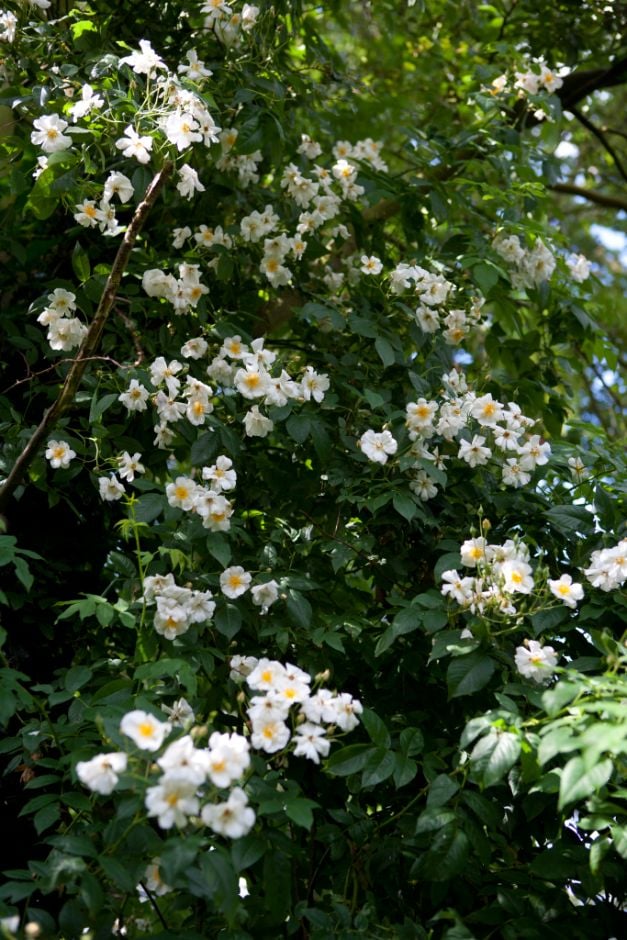Rosa multiflora (Ra)
many-flowered rose
A large rambling rose producing dense growth of arching stems that can make a large shrub, or scramble into a tree. The rather dull green leaves have seven to nine leaflets, and the stems are very thorny. The small, white, slightly fragrant, single flowers are carried in conical trusses, and followed by pea-sized, round, red hips
Synonyms
Rosa polyanthaSize
Ultimate height
4–8 metresTime to ultimate height
5–10 yearsUltimate spread
2.5–4 metresGrowing conditions
Moisture
Moist but well–drained, Well–drainedpH
Acid, Alkaline, NeutralColour & scent
| Stem | Flower | Foliage | Fruit | |
| Spring | Green | |||
|---|---|---|---|---|
| Summer | White | Green | ||
| Autumn | Green | Red | ||
| Winter |
Position
- Full sun
- Partial shade
Aspect
West–facing or South–facing or North–facing or East–facing
Exposure
Exposed or Sheltered Hardiness
H6Botanical details
- Family
- Rosaceae
- Native to GB / Ireland
- No
- Foliage
- Deciduous
- Habit
- Climbing
- Potentially harmful
- Fruit are ornamental - not to be eaten. Wear gloves and other protective equipment when handling. Pets: Fruit are ornamental - not to be eaten - see the HTA guide to potentially harmful plants for further information and useful contact numbers
- Genus
Rosa can be deciduous or semi-evergreen shrubs or scrambling climbers, with usually thorny stems bearing compound pinnate leaves and solitary or clustered flowers. Flowers may be followed by showy red or purple fruits in some varieties.
- Name status
Correct
- Horticultural Group
- Rambler roses are vigorous shrubs with long, arching, thorny or smooth stems carrying glossy foliage and large sprays of small, single or double, often fragrant flowers in early summer
- Plant range
- Japan Korea
How to grow
Cultivation
Grows best in fertile, humus-rich, moist but well-drained soil in a sunny, open position, but tolerates a wide range of conditions. Mulch in late winter and, to improve flowering, apply a balanced fertiliser in late winter or early spring
Propagation
Propagate by softwood cuttings in early to mid spring, hardwood cuttings in late summer to autumn or by chip budding in summer; propagate by seed; species roses can be propagated by seed but need stratification and germination may take two seasons
Suggested planting locations and garden types
- Cottage and informal garden
- Banks and slopes
- Flower borders and beds
- Wall side borders
Pruning
Pruning group 18 (rambler roses) - see our video How to prune rambling roses. Don't prune after flowering if fruits (hips) are required
Pests
May be susceptible to aphids, including rose aphid, the most common rose pest. May also be susceptible to rose leafhopper, glasshouse red spider mite, scale insects, caterpillars, large rose sawfly, rose leaf-rolling sawfly and leaf-cutter bees. Deer and rabbits can also cause damage
Diseases
May be susceptible to rose black spot, rose rust, replant disease, rose dieback, and rose powdery mildews. May also be susceptible to disorders rose blindness and flower balling and sometimes honey fungus
Get involved
The Royal Horticultural Society is the UK’s leading gardening charity. We aim to enrich everyone’s life through plants, and make the UK a greener and more beautiful place.
